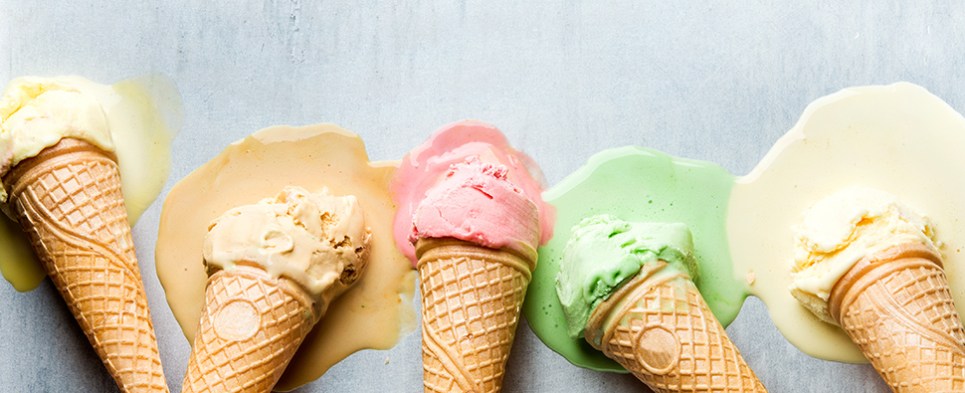Ice Cream Through the Ages, and Across Continents
You know, there are a lot of similarities between beer and ice cream. One’s a delicious treat on a hot day that can nevertheless prove harmful if consumed too greatly or too quickly, and therefore should be monitored around children; the other is ice cream. There is another similarity: Both are ancient products experiencing increasing global popularity as much of the developing world develops middle-class tastes. And what tastes better than ice cream? (You know, besides beer …)
-
Like seemingly every product ever invented, ice cream can trace its origins to China, where a frozen mixture of milk and rice was concocted around 2000 B.C. but, as noted by Rhonda Parkinson, author of The Everything Chinese Cookbook, “Ice cream never caught on in China, both because of a lack of refrigeration in Chinese homes and because the Chinese believe it is unhealthy to eat completely frozen foods.”
-
Another problem was that the Chinese saw ice cream as a luxury item to be consumed only on very special occasions instead of after your kid’s softball game as it is here in the States. All that has changed with the emergence of the Chinese middle class, which is increasingly demanding better and tastier emblems of Western culture. In fact, the country—which ranks first in global trade of luxury items—passed the U.S. in 2014 as the world’s biggest ice cream market.
-
The change started around 2008 when premium brands such as Bronx-based Häagen-Dazs (yes the Bronx, Pierre, though they’re now headquartered in Oakland) and premium boutique brands such as Bassetts out of Philadelphia started exporting to the Chinese. From 2008 to 2014, ice cream sales in China grew 90 percent to $11.4 billion while sales in the U.S. increased 15 percent to $11.2 billion.
-
Bassetts is America’s oldest ice cream company, founded in 1861, and has traditionally been sold exclusively on the East Coast. When its owner Michael Strange was initially—then repeatedly—approached by a Chinese distributor to export to China, he balked out of concern that the technology didn’t exist to safely ship ice cream, which must be kept at temperatures much lower than other frozen foods. “Frozen French fries are kept at 20 degrees,” Strange says. “Ice cream has to be a consistent minus-20 degrees Fahrenheit.”
-
Bassetts’ worst-case scenario happened on its first export shipment, when it arrived a melted, bubbling mess—but not because the technology to keep it cold failed. “Someone forgot to plug in the container,” Strange says.
-
Nowadays there are containers specifically designed to transport cold products at extremely low temperatures. Just as important are temperature tags: computer chips that monitor and audit temperatures. There are about a dozen tags on each Bassetts container, tracking temperature spikes or drops, though there hasn’t been a single additional melting incident. That’s saying a lot; about 20 percent of its ice cream is now exported to China.
-
Another similarity ice cream has with beer is the development of a local, artisanal element in the market that inhibits the spread of international brands. In Europe, surveys have shown that anywhere from one-third to half of consumers in England, France, Germany, Italy and Spain say they prefer ice cream made from locally sourced ingredients using “authentic production methods” such as handmade or slow-churned.
-
“Handcrafted ice cream, made with a homemade-style authenticity, is well positioned to embrace the wider consumer interest in artisan-produced food and drink,” says global food analyst Alex Beckett of market research outfit Mintel. “Craft has become something of a buzzword in recent years, with everything from alcohol to pasta sauces. … [There are] craftsmanship or origin stories on packaging to differentiate the brand from the competition.”
-
Exporters know they must be knowledgeable of local tastes. Early on, Bassetts began experimenting with new flavors in China, finding success with Green Tea and Black Sesame options. At Häagen-Dazs retail establishments in China, one can find traditional moon cakes, which natives eat at the mid-Autumn festival, as well as something called the “Ice Cream Hot Pot,” which allows customers to melt their treat and dip fruit and nuts in it.
-
One flavor that didn’t change was Hokey-Pokey out of New Zealand, a combination of vanilla and honeycombed toffee that has found enormous popularity in Japan.
-
The quality of New Zealand’s ice cream is world renowned, which is probably one reason that New Zealanders consume 28 liters of it annually, the top figure in the world. Americans place second, wolfing down about 20 liters each—though you wouldn’t know it since who the heck knows what a liter is? We’re used to pints, yet another commonality with beer.
-
Speaking of beer … While New Zealanders’ 28 annual liters of ice cream puts them atop the charts like a cherry, it’s small potatoes when it comes to beer, where the citizens of the top-consuming nation, the Czech Republic, put away about 143 liters a year. Sweet.





Leave a Reply